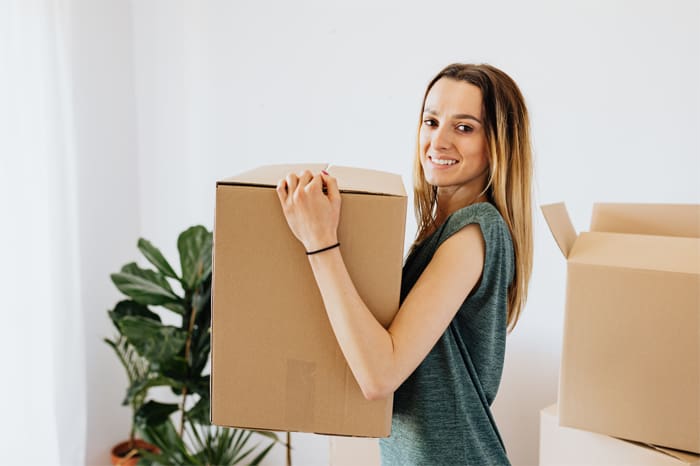
Photo by Karolina Grabowska from Pexels
10 Tips When Packing for a Move
Packing all your belongings in cardboard boxes for a move can be overwhelming! You may start with great enthusiasm and a commitment to organization, but after the 10th box or so you may be tempted to just start throwing everything into any box that's handy.
When you arrive at your new home, you'll thank yourself if you've followed these 10 tips for packing. Boxes that are organized and well labeled will make unpacking and finding important items a lot easier at your destination. Happy packing!
1. Sturdy boxes
Invest in good boxes! At the end of your move, flimsy and oversized boxes will create the most headache. Ask your moving company if they sell recycled boxes. Grocery store boxes are free if you can grab them before they are crushed; however, they can be odd sized and awkward.
Keep the majority of your boxes medium sized. This reduces the possibility of your packed boxes becoming too heavy.
2. Clear packing tape (2-3 rolls)
Invest in a dispenser for each person who will be taping boxes. Secure the bottom of each box before you start to pack.
3. Invest in protective materials
Ask your mover if they provide inkless newspaper for free or for a nominal charge. Otherwise you can find this material, as well as a roll of bubble wrap, at suppliers like Walmart and U-Haul. U-Haul also has special boxes to use for flat-screen TVs and framed art.
4. Moving Day Survival Items
One of the more frustrating aspects of moving day is not being able to find the things you need! Designate an area for your supplies, especially if you plan to clean once the rooms are emptied.
If you plan to clean your home as the rooms are emptied by the movers, take note: professional movers may not empty a room before moving on to the next. Once the major furniture has been removed, ask them to completely empty each room of its boxes. Suggest that they stack the boxes in the garage or driveway until they are ready to load them on to the truck. If the boxes must stay in the room, just start your cleaning and push the remaining boxes into the hallway. We always start with the kitchen. When the last room is cleaned, pack up your cleaning supplies and mark the box “unpacking tools” (see tip #5). We throw the vacuum on to the moving truck before it pulls away.
Supplies:
*lots of cold bottled water
*soft drinks
*food for everyone helping
*1-2 big, black permanent markers for marking boxes
*colored markers to coordinate with the color designated for each room (see tip #7 below)
*scissors
*Kleenex
*toilet paper
*hand soap
*paper towels
*trash bags – get a roll of 50
*scrubbing brush or sponges with one side that scrubs
*broom/dustpan
*mop
*vacuum cleaner
*spot cleaner for carpet
*bathroom cleaner
*glass cleaner
5. Destination Box
Designated boxes are needed for your important documents, your unpacking tools, and basic comforts should the moving truck arrive late. Destination homes frequently do not have toilet paper and are often left unclean.
Set aside 1-2 medium-sized boxes and label with large words UNLOAD FIRST. Personally transport these boxes in your car, especially the box/folder with your important documents.
If you rely on the mover to transport your ‘unpacking tools’ box, be aware that large moving companies can combine your load with a 2nd or even 3rd load, especially during cross-country moves. If the mover is responsible for your ‘unpacking tools’ box, have them load it last and ask that it be placed where it will be unloaded first.
Box #1 – Important Documents (you don’t want to lose)
*folder with moving info and bill of lading
*contact name and number for your moving company (Especially a contact number for your destination)
*personal financial and banking information
*contact numbers for reporting lost credit cards
*safety deposit box items
*checkbook and extra checks
*personal family medication
*family medical records
*address book
*additional key for your car
*manila envelope to store bills and budget information
*plain envelopes, plain writing pad, stamps
Box #2 – Unpacking Tools
*toilet paper
*hand soap for bathrooms and kitchen
*roll of paper towels
*2-3 scissors for opening boxes
*plastic cups for drinking water
*box of Kleenex
*box of garbage bags (for all the unpacking debris)
*unloading map (see tip #9)
Box #3 – Comfort Box (if truck is late or breaks down)
*2-3 wash clothes
*2-3 towels
*pajamas for everyone
*family toothbrushes
*sheets for every bed
*change of clothes for everyone
*deodorant, shampoo, body soap, blow-dryer
6. Pack Rooms Separately
Don’t throw kitchen items into a bathroom box just because there’s room. Mixing room contents will drive you crazy when it comes time to unpack.
When boxes are unloaded, they are placed in their correct rooms. More items are lost during a move when they are quickly thrown into a box marked for another room.
7. Color Code Boxes By Room
Assign a different colored marker for each room in your house and use only that color when labeling boxes.
Try red for the kitchen, purple for living room, orange for bathrooms, pink for a girl’s room, blue for a boy’s room, green for the master bedroom, etc.
Write the room name on the top and sides of each box.
8. Prioritize Your Boxes
After a move, the sheer number of boxes can seem overwhelming. Prioritize your boxes from the beginning to help you focus on unpacking your important boxes first.
As you pack each room, always have three open boxes. Label the first box #1, the second box #2 and the last box #3.
Box #1 – Pack with items that will need to be unpacked first. This could be silverware, pans, food, bedding, towels, your child’s favorite toys, the current season’s clothes, etc.
Box #2 – Pack with items that are not immediately necessary and can be emptied in the 2nd wave of unpacking. This could be books, knickknacks, your child’s secondary toys, off-season clothes, excess bedding, etc.
Box #3 – Pack with items that can be unpacked last or even kept in storage.
The outside of each box should be marked using a specific colored marker indicating the room name and a priority number for unpacking.
9. Packing Breakables
*Wrap glassware individually using several sheets.
*Crunch up paper and place in between breakables.
*Use your dish towels to help wrap breakable kitchen items.
*Pack breakables in the top half of the box.
10. Unloading Map for the New Home
A simple color-coded map can answer a lot of questions when unloading boxes. On a piece of white paper, list the room names using the same marker color you labeled the boxes with for that room. Tape this ‘map’ at the entry of your home.
KITCHEN
BATHROOM
MASTER BEDROOM
GARAGE
Near the entry of each room, tape a piece of paper that displays a large X. Use the color you labeled the boxes with for that room.
X
X
X
X
The movers can match the colors on the boxes with the colors on your room maps. For long hallways or multiple levels use colored arrows to point the way. Kids love creating these signs.
